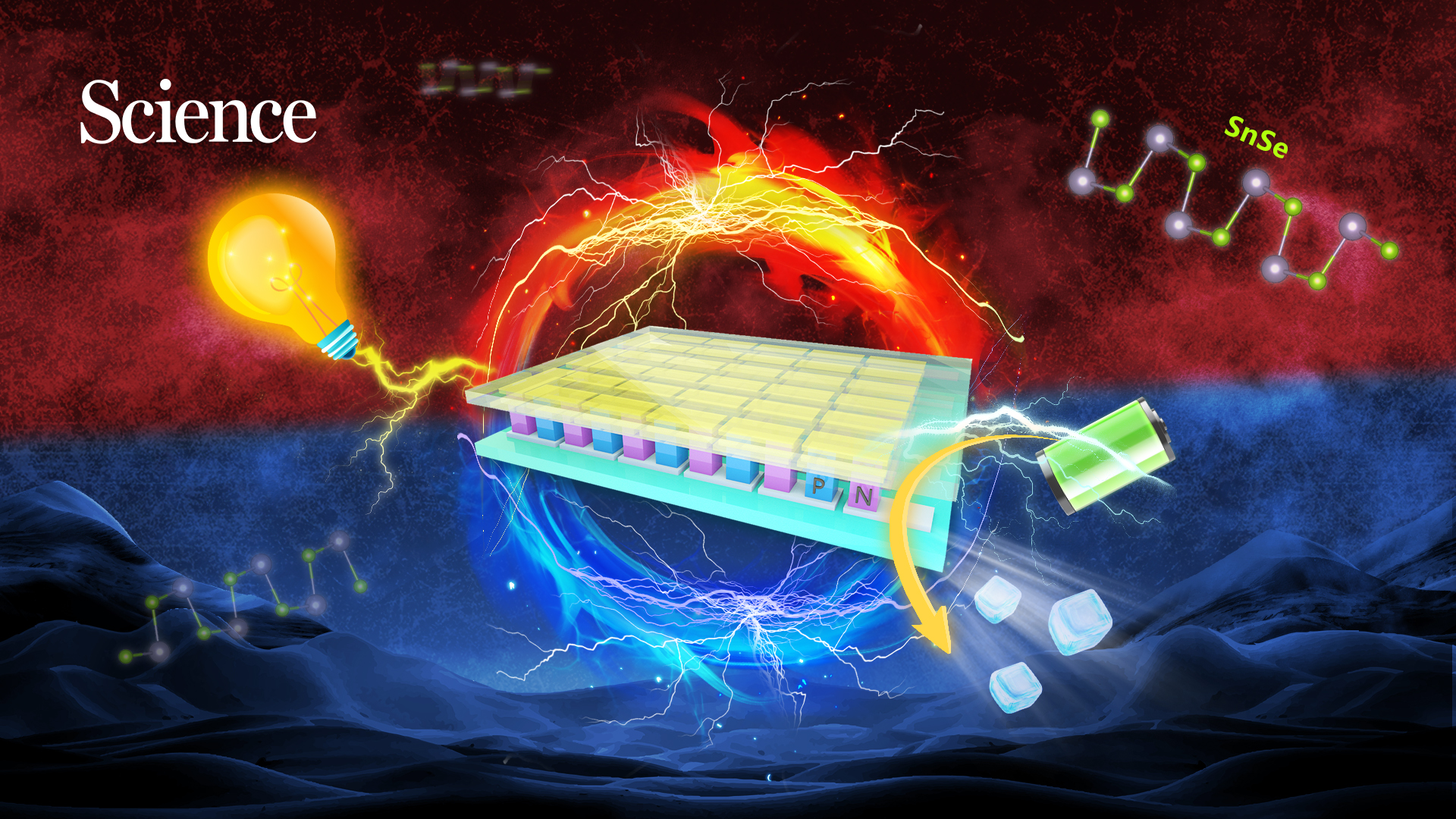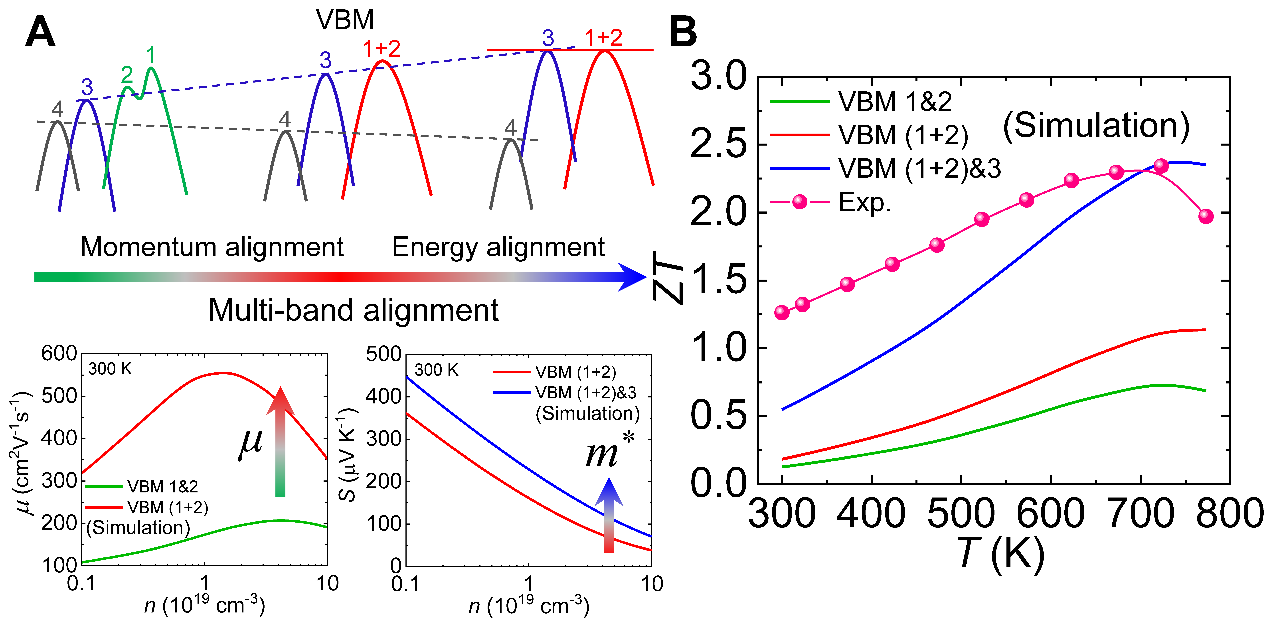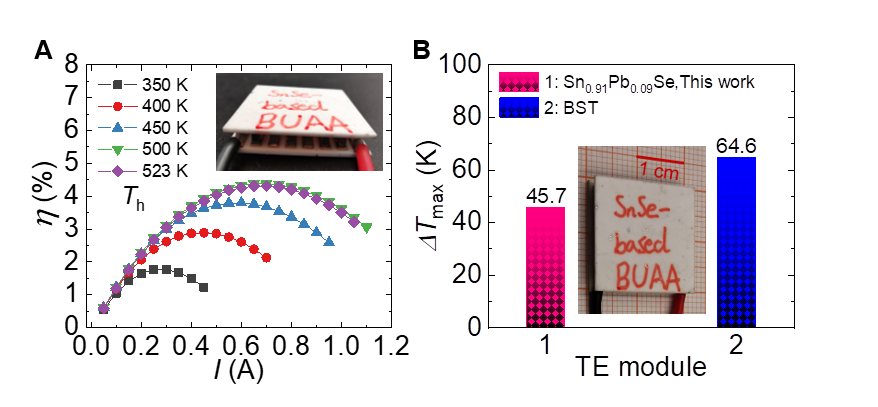SUSTech Jiaqing He’s research team makes significant progress in SnSe based thermoelectric materials and devices
Xixi LIU 2021-07-09
Recently, the team led by Professor Jiaqing He from the Department of Physics at the Southern University of Science and Technology (SUSTech) made great progress in SnSe based thermoelectric (TE) materials. Their results, entitled “Momentum and energy multi-band alignment enable power generation and thermoelectric cooling,” have been published in one of the most famous international journals, Science.

TE conversion technique is a new kind of energy technology based on semiconductor materials. The Seebeck effect or Peltier effect can convert heat into electricity and vice versa, highly contributing to the waste heat recovery and microelectronics temperature control field, respectively. Compared with the conventional energy conversion technology, TE technology illustrates a unique applying value, because of the advantages of high reliability, no moving parts, no pollution, and no noise, in aerospace and integrated circuits fields. For example, radioisotope thermoelectric power (RTG) used in deep space exploration and temperature control devices applied in advanced integrated circuit systems can seldom work well without the TE materials.
Generally, the efficiency of TE materials is determined by a dimensionless figure of merit, defined as ZT (ZT = S2σT /κ), where S, σ, T, κ are the Seebeck coefficient, electrical conductivity, absolute temperature, and thermal conductivity, respectively. According to the equation, an ideal high-performance TE material should contain a large S to create a significant potential difference, a high σ to minimize the Joule heating, and a low κ to maintain a large temperature gradient simultaneously. However, these parameters are strongly coupled with each other, resulting in a considerable bottleneck in enhancing the performance of TE materials.
To date, several effective strategies to improve the ZT value have been reported. Such methods include optimizing the carrier concentration to enhance the electrical conductivity, tuning the electronic band structure, crystal structure, or phase structure for the better electrical transport property (PF = S2σ). Secondly, introducing point defects, dislocations, grain boundaries, nano-scale precipitates, or the multi-scale hierarchical to reduce the thermal conductivity, magnetic nanoparticles, functional unit ordered structure, or high entropy design composites to decouple the electrical and thermal transport parts. Thirdly, exploring new TE materials with intrinsic low lattice thermal conductivity and predicting promising TE stars by high-throughput and gene computing calculation techniques. Here, a fresh optimization perspective has been appeared in this work, leading to a significant enhancement of the SnSe-based TE materials.
In this work, they reported that by aligning multi-band structures in both momentum and energy spaces, one could realize super high performance in p-type SnSe crystals. Additionally, the TE device based on corresponding SnSe material was fabricated, applying TE power generation and TE cooling. The results demonstrated that SnSe-based materials contained great application potential as both TE generation and refrigeration materials, owing to the advantages of low cost, abundance, and light.
The research mainly focuses on synergistically optimizing the effective mass m* and mobility μ, therefore, leading to improved electrical transport properties. Typically, a more prominent power factor in the low-temperature area takes better TE cooling prospects. To further understand the optimizing mechanism, high-temperature synchrotron radiation X-ray diffraction (SR-XRD) results combined with the electronic band structure calculations have been conducted in this project. Then, the fresh “momentum and energy multi-band alignment effect” caused by the merging of multiple valence bands was observed in SnSe. As shown in Figure 1, the momentum alignment corresponds to the merging process of the first and second valence bands, which significantly increases mobility μ and conductivity σ. The energy alignment substantially contributed to the strengthened m* and Seebeck coefficient S corresponds to the merged pudding-mold band (VBM (1 2)), experienced an energy convergence with the third valence band (VBM 3), which effectively enhances the effective mass m* and Seebeck coefficient S. The momentum and energy multi-band alignment effect is further promoted through Pb alloying (9% Pb), leading to ultra-high ZT values of p-type SnSe crystals.
 Figure 1. Multi-band alignment, leading to ultra-high ZT values
Figure 1. Multi-band alignment, leading to ultra-high ZT values
In addition, the TE device was fabricated based on the optimized p-type SnSe TE materials, characterizing the TE generating and cooling performance simultaneously. As shown in Figure 2A, the device can exhibit a high conversion efficiency of 4.4% at a temperature difference of about 210K, equivalent to the commercial bismuth telluride-based thermoelectric device at the same temperature difference.
As depicted in Figure 2B, a maximum cooling temperature difference of about 45.7 degrees was achieved, which can reach 70% of that of commercial Bi2Te3 devices. Interestingly, compared with the commercial Bi2Te3, the cost of SnSe was reduced by about 54%. With the sharply reduced weight and better machinability, a higher economic value and application foreground have disappeared based on their enhanced SnSe based TE materials.
The assembly and characterization of multiple pairs of thermoelectric devices based on SnSe crystal were attempted for the first time. The results show that the SnSe device contains an excellent power generating efficiency and cooling performance. This study overturns the traditional understanding that only narrow bandgap or semi-metal materials can be used as thermoelectric cooling materials. It indicates that the wide-band gap SnSe materials significantly apply potential as both TE generating and cooling materials. According to the vast advantages mentioned above, this study opens the door for the applications of SnSe based TE materials applications in various scenarios, such as the advancing 5G chips and future communication apparatus, bringing higher social value and economic benefits.
 Figure 2. Thermoelectric power generation efficiency and maximum cooling temperature difference of thermoelectric devices based on p-type SnSe crystal
Figure 2. Thermoelectric power generation efficiency and maximum cooling temperature difference of thermoelectric devices based on p-type SnSe crystal
The Department of Physics at SUSTech jointly carried out this work with the School of Materials Science and Engineering at Beihang University. Tsinghua University and the Wuhan University of Technology also made contributions to this work. Chair Professor Jiaqing He at SUSTech and Professor Lidong Zhao from Beihang University are the paper’s co-corresponding authors.
This work was supported by the National Natural Science Foundation of China (NSFC), the Science and Technology Innovation Committee Foundation of Shenzhen, and a high level of Special funds.
Paper links: https://science.sciencemag.org/content/early/2021/07/07/science.abi8668




